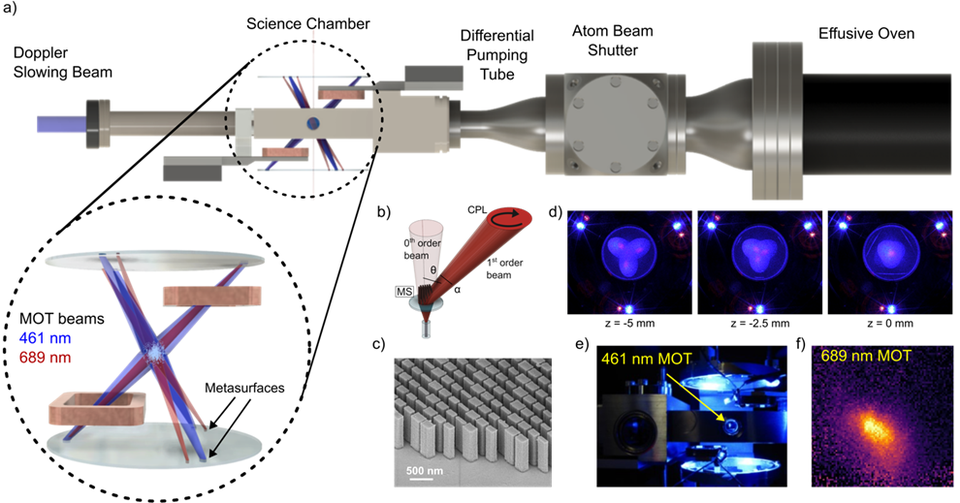Summary
We are developing a scalable infrastructure for strontium optical-lattice clocks based on integrated photonics. This research results in new technologies to enable robust and manufacturable atomic physics systems that are extensible to other quantum-sensor and quantum-information-processing applications. We have demonstrated a compact, ultrahigh vacuum physics package for strontium thermal beam slowing and laser cooling and trapping that is optimized for beam emission with integrated photonics. By integrating metasurface optics on semiconductor wafers, we transform light from a single-mode input to complex, three-dimensional, multi-wavelength, centimeter-scale laser configurations for advanced control of ultracold atomic samples. This project creates a versatile palette of process design for integrated photonics to support atomic physics that can be scaled to semiconductor foundries.
Description
The development of a liter-scale apparatus to produce Sr, would enable highly accurate, transportable optical clocks based on their ultra-narrow optical transition. However, straightforward miniaturization of the traditional optical infrastructure necessary to implement multi-step laser cooling has proved to be prohibitively complex and expensive. Recently developed metasurface (MS) optics consisting of periodic arrays of dielectric nanopillars, are capable of flexible control of the optical phase and offer the potential to perform the function of multiple traditional optics simultaneously in a single wafer-thickness optic, greatly reducing the spatial footprint. In our lab, we combine photonic integrated MS made from titanium dioxide (TiO2) and a low-SWAP Sr source to create a ultra-cold Sr system to support next-generation transportable Sr clock experiments.
The figure presents an overview of our compact Sr apparatus, which is built around integrated photonics. Hot Sr atoms are emitted by a small effusive oven and are collimated to form a thermal atomic beam, which can be turned off and on with a mechanical shutter. A differential pumping tube maintains ultra-high vacuum in the science chamber where Sr atoms are decelerated by a Doppler slowing beam and then trapped in our two-color MOT. The figure inset shows an enlargement of the key components of our integrated MOT. The trapping beams for both the 461 nm broad linewidth MOT and the 689 nm narrow linewidth MOT are generated from optical metasurfaces on semiconductor wafers. Our modified quadrupole coil geometry (square brown rings in the figure) achieves the field gradient necessary for trapping and has excellent optical access to incorporate our metasurface-generated trapping beams.
The multifunctional optical design and nanostructure of our MS illustrate how we leverage semiconductor fabrication methods to create an alignment-free MOT. Each of our MS is designed to perform three optical functions simultaneously: 1) alter the beam’s divergence angle α, 2) deflect it by an angle θ, 3) and convert the polarization from linear to circular. In traditional optical systems, such a transformation would require a focusing lens, a steering mirror, and a quarter waveplate, each of which must be carefully aligned. In our experiment, we rely on the scalable manufacturing capabilities of semiconductor foundries to build these functionalities directly into the nanophotonics design, eliminating alignment steps. Our chosen TiO2 pillar height of 900 nm can support efficient designs at wavelengths λ = 461 nm and 689 nm on a single wafer; see representative SEM images in the figures. We use a correspondence between nanopillar geometry and optical phase shift to create arbitrary phase profiles in the transverse plane by a suitable arrangement of pillar sizes. Figure panel d shows photographs of the 461 nm (blue) and 689 nm (red) beams being emitted by a single wafer at different heights, with all 6 beams coming to a common intersection at the trap center, z=0. We have used this system to create robust, alignment-free MOTs for 88Sr at both 461 nm and at 689 nm.

Publications
[1] A. R. Ferdinand et al., A Scalable Infrastructure for Strontium Optical Clocks, in Conference on Lasers and Electro-Optics (2022), Paper STu5O.1 (Optica Publishing Group, 2022), p. STu5O.1.
[2] Z. Newman, D. Carlson, A. Ferdinand, and S. B. Papp, Engineered Multi-Output Supercontinuum Generation in Tantala Waveguides for Optical-Lattice-Clock Stabilization, in 2022 Conference on Lasers and Electro-Optics (CLEO) (2022), pp. 1–2.
[3] G. Spektor et al., Universal Visible Emitters in Nanoscale Integrated Photonics, arXiv:2206.11966.
Major Accomplishments
- Demonstration of Sr laser cooling and trapping with 461 nm and 689 nm transitions by use of integrated metasurface optics.
- Development of supercontinuum with integrated photonics for laser stabilization of all the lasers needed for a Sr optical lattice clock.

